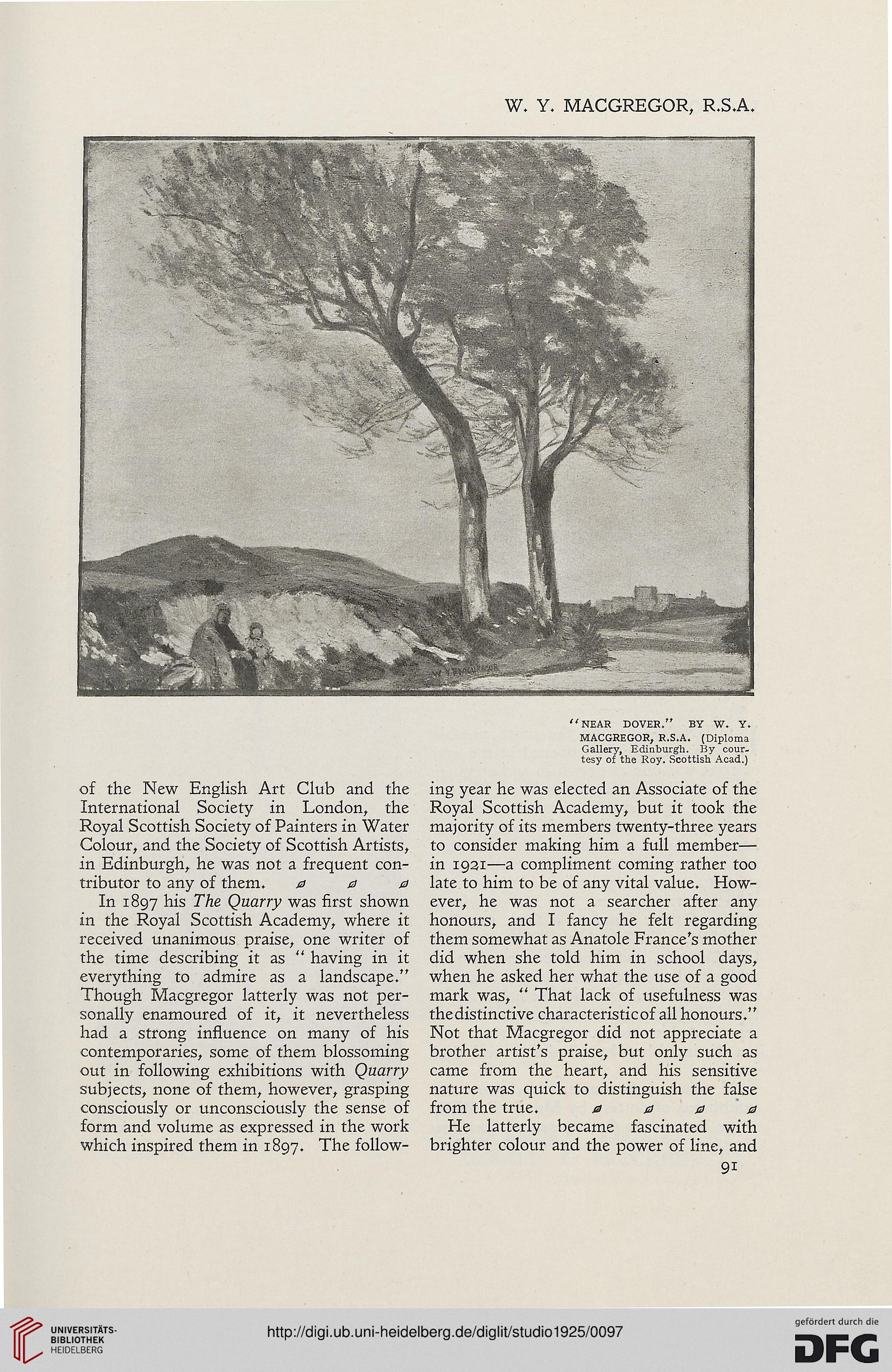W. Y. MACGREGOR, R.S.A.
of the New English Art Club and the
International Society in London, the
Royal Scottish Society of Painters in Water
Colour, and the Society of Scottish Artists,
in Edinburgh, he was not a frequent con-
tributor to any of them. a a a
In 1897 his The Quarry was first shown
in the Royal Scottish Academy, where it
received unanimous praise, one writer of
the time describing it as " having in it
everything to admire as a landscape."
Though Macgregor latterly was not per-
sonally enamoured of it, it nevertheless
had a strong influence on many of his
contemporaries, some of them blossoming
out in following exhibitions with Quarry
subjects, none of them, however, grasping
consciously or unconsciously the sense of
form and volume as expressed in the work
which inspired them in 1897. The follow-
" NEAR DOVER." BY W. Y.
MACGREGOR, R.S.A. (Diploma
Gallery, Edinburgh. By cour-
tesy of the Roy. Scottish Acad.)
ing year he was elected an Associate of the
Royal Scottish Academy, but it took the
majority of its members twenty-three years
to consider making him a full member—
in 1931—a compliment coming rather too
late to him to be of any vital value. How-
ever, he was not a searcher after any
honours, and I fancy he felt regarding
them somewhat as Anatole France's mother
did when she told him in school days,
when he asked her what the use of a good
mark was, " That lack of usefulness was
the distinctive characteristic of all honours."
Not that Macgregor did not appreciate a
brother artist's praise, but only such as
came from the heart, and his sensitive
nature was quick to distinguish the false
from the true. a a a a
He latterly became fascinated with
brighter colour and the power of line, and
9i
of the New English Art Club and the
International Society in London, the
Royal Scottish Society of Painters in Water
Colour, and the Society of Scottish Artists,
in Edinburgh, he was not a frequent con-
tributor to any of them. a a a
In 1897 his The Quarry was first shown
in the Royal Scottish Academy, where it
received unanimous praise, one writer of
the time describing it as " having in it
everything to admire as a landscape."
Though Macgregor latterly was not per-
sonally enamoured of it, it nevertheless
had a strong influence on many of his
contemporaries, some of them blossoming
out in following exhibitions with Quarry
subjects, none of them, however, grasping
consciously or unconsciously the sense of
form and volume as expressed in the work
which inspired them in 1897. The follow-
" NEAR DOVER." BY W. Y.
MACGREGOR, R.S.A. (Diploma
Gallery, Edinburgh. By cour-
tesy of the Roy. Scottish Acad.)
ing year he was elected an Associate of the
Royal Scottish Academy, but it took the
majority of its members twenty-three years
to consider making him a full member—
in 1931—a compliment coming rather too
late to him to be of any vital value. How-
ever, he was not a searcher after any
honours, and I fancy he felt regarding
them somewhat as Anatole France's mother
did when she told him in school days,
when he asked her what the use of a good
mark was, " That lack of usefulness was
the distinctive characteristic of all honours."
Not that Macgregor did not appreciate a
brother artist's praise, but only such as
came from the heart, and his sensitive
nature was quick to distinguish the false
from the true. a a a a
He latterly became fascinated with
brighter colour and the power of line, and
9i




